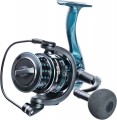The number of bearings provided in the design of the reel. Bearings are used to reduce friction of rotating parts, which, on the one hand, protects such parts from wear, and on the other hand, reduces excessive effort expended when the handle is rotated. Accordingly, the
more bearings, the more friction units are protected and the better the coil is “optimized”; this parameter is a good indicator of the overall class of the product. At the same time, it is necessary to evaluate different models taking into account their purpose (see "Type").
So, in fly fishing reels, even quite expensive ones, 1 bearing is usually provided — at the point of installation of the drum on a bracket designed for attachment to the rod. This is actually the only significant friction point, so more bearings are simply not required. For multiplier reels, this number varies from 1 for relatively simple options to 6 – 7 for premium ones. And in inertia-free bearings, the number of bearings can reach a couple of dozen.
The amount of line that can fit on the main spool of a reel with normal winding. It is indicated as a ratio of two numbers, the first of which corresponds to the length of the reeled line in metres, and the second to the thickness in millimetres: for example, the numbers 200 / 0.45 indicate that up to 200 m of fishing line with a thickness of 0.45 mm can fit on the reel.
For different types of fishing, there are recommendations on the optimal value of this parameter; they can be found in special sources. Here we note that the capacity of the spool is indicated exclusively for a smooth fishing line; when using a braided cord, the actual performance may differ markedly.

